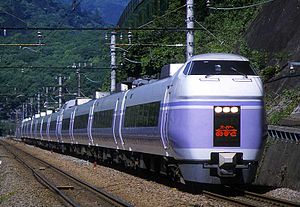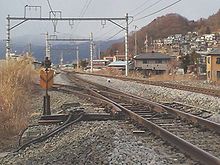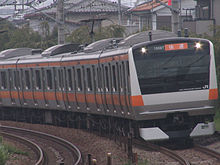- Chūō Main Line
-
Chūō Main Line
中央本線
JR East E351 series Super Azusa limited express between Takao and SagamikoOverview Type Heavy rail Locale Tokyo, Kanagawa, Yamanashi, Nagano, Gifu, Aichi prefectures Termini Tokyo
NagoyaStations 112 Operation Opened 1889 Operator(s) JR East, JR Central Technical Line length 424.6 km (263.8 mi) Track gauge 1,067 mm (3 ft 6 in) Electrification 1,500 V DC overhead catenary Operating speed 130 km/h (80 mph) Route map 
The Chūō Main Line (中央本線 Chūō-honsen), commonly called the Chūō Line, is one of the major trunk railway lines in Japan. It runs between Tokyo and Nagoya, although it is the slowest direct railway connection between the two cities; the coastal Tōkaidō Main Line is slightly faster, while the Tōkaidō Shinkansen is the fastest rail link between the cities.
The eastern portion, the Chūō East Line (中央東線 Chūō-tōsen), is run by the East Japan Railway Company (JR East), while the western portion, the Chūō West Line (中央西線 Chūō-saisen), is run by the Central Japan Railway Company (JR Central). The dividing point between the two companies is Shiojiri Station, where express trains from both ends spur off onto the Shinonoi Line towards the cities of Matsumoto and Nagano. Despite the huge urban areas at either end of the Chūō Line, its central portion is very lightly traveled; the Shiojiri-Nakatsugawa corridor is only served by twice-hourly local and hourly limited express trains.
The route the Chūō Main Line takes is through the mountainous center of Honshū. Its highest point (near Fujimi Station) is about 900 meters above sea level and much of the line has a gradient of 25 per mil. Along the Chūō East Line section, peaks of the Akaishi and Kiso as well as Mount Yatsugatake can be seen from trains. The Chūō West Line runs along the old Nakasendō highway (famous for the preserved post towns of Tsumago-juku and Magome-juku) and the steep Kiso Valley.
Contents
Routes
- Entire Route (Tokyo - Nagoya including branch): 424.6 km
- East Line (Tokyo - Shiojiri): 222.1 km
- Tokyo - Kanda: 1.3 km (officially part of the Tōhoku Main Line)
- Kanda - Yoyogi: 8.3 km
- Yoyogi - Shinjuku: 0.7 km (officially part of the Yamanote Line)
- Shinjuku - Shiojiri: 211.8 km
- East Line - Tatsuno Branch (Okaya - Tatsuno - Shiojiri): 27.7 km
- West Line (Shiojiri - Nagoya): 174.8 km
- Shiojiri - Kanayama: 171.5 km
- Kanayama - Nagoya: 3.3 km (alongside Tōkaidō Main Line)
Stations and services
This section lists all stations on the Chūō Main Line and generally explains regional services on the line. In addition, there are limited express services connecting major cities along the line, namely Azusa, Super Azusa, Kaiji, Hamakaiji, Narita Express and Shinano. For details of the limited express trains, see the relevant articles.
Tokyo - Mitaka
See also: Chūō Rapid Line and Chūō-Sōbu LineThe section between Tokyo and Mitaka is grade-separated, with no level crossings. Between Ochanomizu and Mitaka, the Chūō Main Line has four tracks; two of them are local tracks (緩行線 kankō-sen) with platforms in every station and the other two are rapid tracks (快速線 kaisoku-sen) with some stations without platforms. The local tracks are used by the main line local trains (operated only in early morning and late night) and the Chūō-Sōbu Line local trains, while the rapid tracks carry rapid service and express trains. The Tokyo-Mitaka portion is a vital cross-town rail link, and also the city's best-known suicide location due to the high speed and cramped schedule of the trains.
The commuter services on the rapid tracks are collectively called the Chūō Rapid Line (中央快速線 Chūō-kaisoku-sen) or the Chūō Line (Rapid) (中央線快速 Chūō-sen-kaisoku) in comparison with the Chūō Line (Local) (中央線各停 Chūō-sen-kakutei) or the Chūō-Sōbu Line on the local tracks. The former is usually referred to simply as the Chūō Line and the latter the Sōbu Line. Separate groups of trainsets are used for these two groups of services: cars with an orange belt for the rapid service trains and cars with a yellow belt for the local service trains, with the exception of early morning and late night local service trains which use cars with an orange belt. Signs at stations also use these colors to indicate the services.
This section is located entirely within Tokyo.
Legends for the table
- Local trains:
- S: Chūō-Sōbu Line local trains
- L: Local trains from/to Tokyo operating during early morning and late night hours using rapid train cars
- T: Local trains through to Tōzai Line
- Rapid trains (Chūō Rapid Line):
- R: Rapid (快速 Kaisoku)
- C: Commuter Rapid (通勤快速 Tsūkin Kaisoku)
- S: Chūō Special Rapid (中央特快 Chūō Tokkai) / Ōme Special Rapid (青梅特快 Ōme Tokkai) through to Ōme Line
- T: Commuter Special Rapid (通勤特快 Tsūkin Tokkai)
- Trains pass stations marked with a vertical bar.
Station Distance
(km)Stops
(See legends above)Transfers Location Local Rapid S L T R C S T Tōkyō 0.0 L R C S T Chiyoda Kanda 1.3 L R C S T - Yamanote Line
- Keihin-Tōhoku Line
- Tokyo Metro Ginza Line
Ochanomizu 2.6 S L R C S T Suidōbashi 3.4 S L | | | | Iidabashi 3.4 S L T1 | | | | Ichigaya 5.8 S L | | | | - Tokyo Metro Yūrakuchō Line
- Tokyo Metro Namboku Line
- Toei Shinjuku Line
Yotsuya 6.6 S L R C S T - Tokyo Metro Marunouchi Line
- Tokyo Metro Namboku Line
Shinanomachi 7.9 S L | | | | Shinjuku Sendagaya 8.6 S L | | | | Shibuya Yoyogi 9.6 S L | | | | - Yamanote Line
- Toei Ōedo Line
Shinjuku 10.3 S L R C S T Shinjuku Ōkubo 11.7 S L | | | | Higashi-Nakano 12.8 S L | | | | Nakano Nakano 14.7 S L T R C S2 | - Tokyo Metro Tōzai Line (through service)
Kōenji 16.1 S L T R3 | | | Suginami Asagaya 17.3 S L T R3 | | | Ogikubo 18.7 S L T R C | | Nishi-Ogikubo 20.6 S L T R3 | | | Kichijōji 22.5 S L T R C | | Musashino Mitaka 24.1 S L T R C S | Mitaka - Notes:
- 1: Tōzai Line through trains stop at the Tōzai Line (Tokyo Metro) section of Iidabashi Station. They run on the Tōzai Line instead of the Chūō Line east of Nakano.
- 2: Chūō Special Rapid service down trains started from Shinjuku don't stop Nakano.
- 3: Rapid trains pass these stations on weekends.
Mitaka - Takao
See also: Chūō Rapid LineThe four-track section ends at Mitaka. Currently, construction is ongoing between Mitaka and Tachikawa to elevate the tracks and eliminate level crossings; this section of the line is notorious for its level crossings which can be shut for upwards of an hour during rush hour. Further plans have been proposed to add another two tracks as far as Tachikawa; however, this will not be included in the track elevation, due to be completed between 2008-2011.
This section is also all in Tokyo. For legends on train types, see the preceding section.
Station Distance
(km)Stops Transfers Location Local Rapid S L R C S T Mitaka 24.1 S L R C S | Mitaka Musashi-Sakai 25.7 S L R | | | Seibu Tamagawa Line Musashino Higashi-Koganei 27.4 S L R | | | Koganei Musashi-Koganei 29.1 S L R | | | Kokubunji 31.4 S L R C S T - Seibu Kokubunji Line
- Seibu Tamako Line
Kokubunji Nishi-Kokubunji 32.8 S L R | | | Musashino Line Kunitachi 34.5 S L R | | | Kunitachi Tachikawa 37.5 S L R C S T Tachikawa Hino 40.8 L R C S | Hino Toyoda 43.1 L R C S | Hachiōji 47.4 L R C S T Hachiōji Nishi-Hachiōji 49.8 L R C S | Takao 53.1 L R C S T Keiō Takao Line Takao - Shiojiri
Most of the rapid service trains from Tokyo turn at Takao where the line exits the large urban area of Tokyo. The section between Takao and Ōtsuki still carries some commuter trains as well as long distance local trains and Limited Express trains. The Kaiji limited express terminates at Kōfu, the capital of Yamanashi Prefecture, while the Azusa and Super Azusa continue beyond Shiojiri to the Shinonoi Line.
Station Distance Transfers Location Takao 53.1 Hachiōji Tokyo Sagamiko 62.6 Sagamihara Kanagawa Fujino 66.3 Uenohara 69.8 Uenohara Yamanashi Shiotsu 74.0 Yanagawa 77.6 Ōtsuki Torisawa 81.2 Saruhashi 85.3 Ōtsuki 87.8 Fuji Kyūkō Line Hatsukari 93.9 Sasago 100.4 Kai-Yamato 106.5 Kōshū Katsunuma-budōkyō 112.5 Enzan 116.9 Higashi-Yamanashi 120.1 Yamanashi Yamanashishi 122.2 Kasugaichō 125.0 Fuefuku Isawa-onsen 127.8 Sakaori 131.2 Kōfu Kōfu 134.1 Minobu Line Ryūō 138.6 Kai Shiozaki 142.7 Nirasaki 147.0 Nirasaki Shimpu 151.2 Anayama 154.7 Hinoharu 160.1 Hokuto Nagasaka 166.3 Kobuchizawa 173.7 Koumi Line Shinano-Sakai 178.2 Fujimi Nagano Fujimi 182.9 Suzurannosato 186.1 Aoyagi 188.0 Chino Chino 195.2 Fumonji Junction (198.9) Suwa Kami-Suwa 201.9 Shimo-Suwa 206.3 Shimosuwa Okaya 210.4 - Chūō Line (For Tatsuno)
Okaya Midoriko 218.2 Shiojiri Shiojiri 222.1 - Chūō line (for Tatsuno)
- Shinonoi Line
- Chūō Line (for Kiso-Fukushima and Nagoya)
Okaya – Shiojiri
The Okaya-Shiojiri branch is an old route of the Chūō Main Line. It carries a small number of shuttle trains and trains from/to the Iida Line, which branches off at Tatsuno.
Station Distance Transfers Location Okaya 210.4 Chūō Line (for Kami-Suwa, Midoriko) Okaya Nagano Kawagishi 213.9 Tatsuno 219.9 Iida Line Tatsuno Shinano-Kawashima 224.2 Ono 228.2 Shiojiri 238.1 - Chūō line (for Midoriko)
- Shinonoi Line
- Chūō Line (for Kiso-Fukushima)
Shiojiri Prior to the opening of the new route between Okaya and Shiojiri, there was a junction (Higashi-Shiojiri Junction (東塩尻信号場)) between Ono and Shiojiri stations. It had a zig zag layout. The signal station was closed on October 12, 1983.
Shiojiri - Nakatsugawa
Shiojiri is the dividing point of the East Line and the West Line; no train continues from one to the other. The Shinano limited express is the main player of the rural Shiojiri-Nakatsugawa section.
Station Distance Transfers Location Shiojiri 222.1 (see above) Shiojiri Nagano Seba 226.3 Hideshio 231.0 Niekawa 236.2 Kiso-Hirasawa 241.4 Narai 243.2 Yabuhara 249.8 Kiso (village) Miyanokoshi 255.5 Kiso (town) Harano 258.3 Kiso-Fukushima 263.8 Agematsu 271.1 Agematsu Kuramoto 277.7 Suhara 282.5 Ōkuwa Ōkuwa 285.8 Nojiri 288.8 Jūnikane 292.5 Nagiso Nagiso 298.0 Tadachi 304.3 Sakashita 307.1 Nakatsugawa Gifu Ochiaigawa 313.2 Nakatsugawa 317.0 Chūō Line (for Tajimi, Nagoya) Nakatsugawa - Nagoya
Local and rapid service trains run on the line from Nakatsugawa to Nagoya. This section carries urban traffic of the Greater Nagoya Area.
Legends:
- R: Rapid
- CL: Central Liner
- HL: Home Liner (Only part of Home Liner trains stop at stations marked with an asterisk.)
Station Distance
(km)Stops Transfers Location Nakatsugawa 317.0 R CL HL Nakatsugawa Gifu Mino-Sakamoto 323.4 R CL | Ena 328.6 R CL HL Akechi Railroad Akechi Line Ena Takenami 334.0 R CL | Kamado 339.4 R CL | Mizunami Mizunami 346.8 R CL HL Toki-shi 353.7 R CL HL Toki Tajimi 360.7 R CL HL Tajimi Kokokei 365.3 | | | Jōkōji 368.8 | | | Kasugai Aichi Kōzōji 372.9 R CL HL* Jinryō 376.1 | | | Kasugai 378.8 R | | Kachigawa 381.9 R | | Shin-Moriyama 384.6 | | | Nagoya Ōzone 387.1 R | HL* Chikusa 389.8 R CL HL Tsurumai 391.3 R | HL* Kanayama 393.6 R CL HL - Tōkaidō Main Line
- ♦ Meitetsu Nagoya Line
- ■ Meijō Line
- □Meikō Line
Sannō Junction 395.1 JR Freight Nagoyaminato Branch
Nagoya 396.9 R CL HL - Tōkaidō Shinkansen
- Kansai Main Line
- Tōkaidō Main Line
- Kintetsu Nagoya Line (at Kintetsu Nagoya)
- ♦ Meitetsu Nagoya Line (at Meitetsu Nagoya)
- ■ Higashiyama Line
- ■ Sakura-dōri Line
- Aonami Line
Signals and junctions
- Fumonji Junction (普門寺信号場 Fumonji Shingōjō) is a junction between Chino and Kami-Suwa stations in Suwa, Nagano. It entered into use on September 2, 1970.
- Sannō Junction (山王信号場 Sannō Shingōjō) is a junction that diverts freight traffic from the Chūō Main Line to the Tōkaidō Line freight branch between Kanayama and Nagoya stations in Nagoya. It entered into use on October 10, 1962.
Rolling stock
Chūō East Line (JR East)
New E233 series trains entered service on Tokyo-area commuter services from December 26, 2006. These trains are a development of the E231 series used on other commuter lines in the Tokyo area, and replaced the aging 201 series rolling stock introduced on the line in 1981.
- Chūō Rapid Line
- Chūō-Sōbu Line
- Tokyo Metro Tōzai Line
- Local Trains
- 115 series
- 119 series
- 123 series
- Limited Express
- E257 series (Azusa, Kaiji, Chūō Liner, Ōme Liner)
- E351 series (Super Azusa)
- 253 series (Narita Express) (One train per day starts/terminates at Takao)
- Seasonal services
- 183 series (Azusa, Wing Azusa, Moonlight Shinshū)
- 185 series (Hamakaiji)
- 215 series (View Yamanashi)
Chūō West Line (JR Central)
- Local Trains
- 115 series
- 211 series
- 213 series
- 311 series
- 313 series
- Limited Express
- 383 series (Shinano)
- 381 series
Freight train
History
The oldest portion of the Chūō Line is the segment from Shinjuku Station to Tachikawa Station, which dates back to 1889. The extension westward continued through the turn of the century, with Hachiōji Station and eastern Yamanashi prefecture in 1901, and Kōfu in 1903. The West Line from Nagoya started in 1900. The East and West lines were connected in 1911.
The section between Iidamachi Station (formerly located between Suidōbashi Station and Iidabashi Station) and Nakano Station was the first urban electric railway in Japan.
On September 12, 1997, a Super Azusa limited express bound for Matsumoto collided with a 201 series local train that failed to stop at a red signal while passing through Ōtsuki Station.
Chūō Main Line construction timeline Section Date of opening Builder East Line Tokyo 1919-03-01 JGR Manseibashi † 1912-04-01 Shōheibashi † 1908-04-19 Ochanomizu 1904-12-31 Kōbu Iidamachi † 1895-04-03 Ushigome † 1894-10-09 Shinjuku 1889-04-11 Tachikawa 1889-08-11 Hachiōji 1901-08-01 JGR Uenohara 1902-06-01 Torisawa 1902-10-01 Ōtsuki 1903-02-01 Kai-Yamato
(Hajikano)1903-06-11 Kōfu 1903-12-15 Nirasaki 1904-12-21 Fujimi 1905-11-25 Okaya 1983-07-05
(See note below)JNR Shiojiri West Line 1909-12-01 JGR Yabuhara 1910-10-05 Miyanokoshi 1911-05-01 Kiso-Fukushima 1910-11-25 Agematsu 1910-10-05 Suhara 1909-12-01 Nojiri 1909-09-01 Nagiso (Midono) 1909-07-15 Sakashita 1908-08-01 Nakatsugawa
(Nakatsu)1902-12-21 Tajimi 1900-07-25 Nagoya Notes:
- The section between Okaya Station and Shiojiri Station is the new route that replaced the old route opened on June 11, 1906 by JGR.
- Station names in parentheses are original names.
- Stations marked † are now closed.
- Prior to the connection of the East Line and the West Line in 1911, the section between Shiojiri Station and Miyanokoshi Station belonged to the East Line.
References
External links
Mass transit in Nagoya (Chūkyō)  Municipal Subway lines
Municipal Subway linesMeitetsu lines Kintetsu lines (Chūkyō)  JR Central lines
JR Central linesOther lines Miscellaneous Terminals: Kanayama • Kintetsu Nagoya • Meitetsu-Nagoya • Nagoya • Ōzone • Sakae
Cards: Manaca • TOICA • Tranpass
Other: Transportation Bureau City of Nagoya • Transport in Greater NagoyaJR East lines Shinkansen 
Main Local Agatsuma · Akabane · Aterazawa · Ban'etsu East · Ban'etsu West · Echigo · Gonō · Hachikō · Hachinohe · Hakushin · Hanawa · Iiyama · Ishinomaki · Itō · Itsukaichi · Iwaizumi · Jōban · Jōetsu · Kamaishi · Karasuyama · Kashima · Kawagoe · Keiyō · Kesennuma · Kitakami · Koumi · Kururi · Mito · Musashino · Nambu · Narita · Negishi · Nikkō · Ōfunato · Oga · Ōito · Ōme · Ōminato · Rikuu East · Rikuu West · Ryōmō · Sagami · Senseki · Senzan · Shinonoi · Sotobō · Suigun · Tadami · Takasaki · Tazawako · Tōgane · Tsugaru · Tsurumi · Uchibō · Yahiko · Yamada · Yamanote · Yokohama · Yokosuka · YonesakaOthers Chūō Rapid · Chūō-Sōbu · Gala-Yuzawa · Keihin-Tōhoku · Saikyō · Shōnan-Shinjuku · Sōbu Rapid · (Tōhoku Jūkan - under construction)Past JR Central lines Shinkansen 
Main Local Past Categories:- Lines of East Japan Railway Company
- Lines of Central Japan Railway Company
- Railway lines opened in 1889
- 1067 mm gauge railways in Japan
Wikimedia Foundation. 2010.







